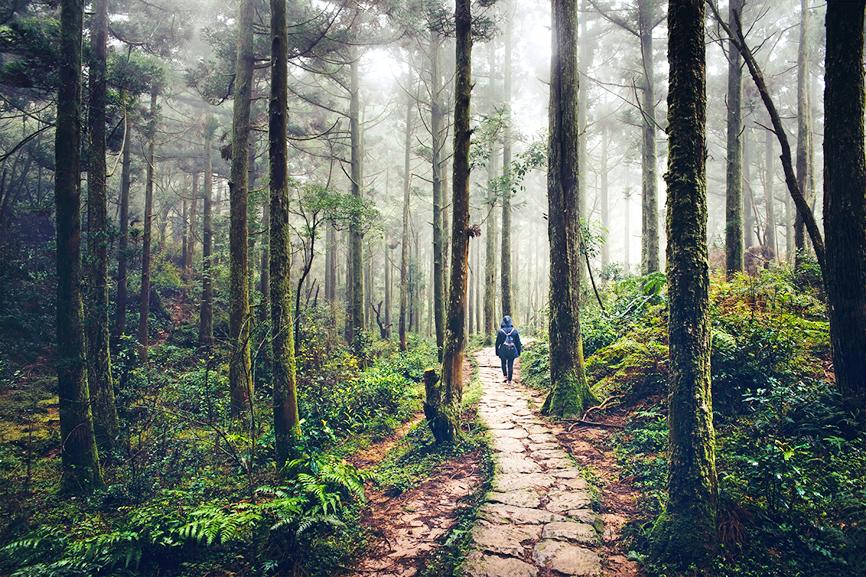The Taipei City Government is running a promotion throughout the year to encourage people to visit the Taipei Grand Trail (台北大縱走), a 92km hiking trail which is 1,120m above sea level at its highest point, and which runs through the mountains surrounding Taipei.
The Taipei Grand Trail was launched by the Taipei Public Works Department’s Geotechnical Engineering Office in 2018, integrating more than 100 existing hiking trails that connect the five mountain areas surrounding the Taipei basin — the Datunshan (大屯山), Qixingshan (七星山), Wujhihshan (五指山), Nangangshan (南港山) and Ergeshan (二格山) areas.
The trail is divided into seven sections, each ranging from 11km to 18km, enabling people to complete each in one day, the office said.

Photo courtesy of the Taipei City Government
The trail has bilingual directions, toilets and drinking fountains along it, and people can easily access each section by using public transportation, it added.
Chen Yen-chen (陳彥成), chief of the office’s Industrial and Trail Section, said that the trail includes places of cultural interest, such as temples and ancient trails, and each section has its own distinctive scenery.
The entire trail can be completed in about seven to eight days, and doing so would burn about 38,000 calories, he said.
In 2018, the office installed 12 pillars along the trail so that people could take photographs at them as a record of their hiking experience.
The program this year began on Jan. 1 and runs through Dec. 31, so people can visit the seven sections throughout the year, he said.
People who take photos of themselves at each of the 12 pillars and submit a collage of them to the office would receive a certificate and a souvenir towel, Chen said, adding that they can also keep a record of their hikes by using the Hiking Biji (健行筆記) mobile app.
Hikers also have the option of using the app to collect 49 virtual gems — seven on each section of the trail — and receive an online completion badge and certificate from the Hiking Biji Web site.
If they bring the online certificate to the office, they can receive a paper certificate, a souvenir towel and a gauze towel with the Taipei Grand Trail logo printed on it.
Chen said that a lottery would be held at the end of the year, the information for which would be posted on the Taipei Grand Trail’s Facebook page (facebook.com/Taipei.Trail).
Information about the certification program and detailed maps of each section are available on the office’s official Web site at gisweb.taipei.gov.tw/release/.
Section one of the trail is 13km long and takes about seven to eight hours to walk. It starts at the Guandu MRT Station. One-third of it runs through Yangmingshan National Park and it ends in the park at Erziping Tourist Service Station (二子坪遊客服務站).
The section includes Guizikeng Trail (貴子坑步道), where people can go camping at the nearby Guizikeng campground or visit the Guizikeng Water and Soil Conservation Education Park to see Taipei’s oldest geological formation, the Wujhihshan stratum.
Section two is 12km long and takes about six to seven hours to walk. It starts at Erziping Tourist Service Station and includes several trails in Yangmingshan National Park, as well as Datunshan’s main peak, west peak and south peak, and ends at Xiaoyoukeng Tourist Service Station (小油坑遊客服務站).
Among the trails included is the Erziping Trail, which was called the “Butterfly Corridor” in the 1990s, as more than 130 butterfly species from five families have been recorded in the area.
Wu Chien-chun (吳健?), the office’s chief engineer, has said that section two is the most challenging section, as people need to use their hands and feet, pulling themselves up on ropes and hiking along steep pathways.
Despite the challenge, this section has some of the most beautiful scenery, he said.
People can watch butterflies in May and June along the Erziping Trail, and view endless fields of white calla lilies in March and April and blooming hydrangeas in early summer at the Zhuzihu (竹子湖) area, as well as Xiaoyoukeng (小油坑), a post-volcanic geological site, he said.
Section three is 13km long and takes about seven to eight hours to walk. It starts at Xiaoyoukeng Tourist Service Station, goes to Qixingshan’s main peak and east peak, covers Qingtiangang (擎天崗), Dingshan (頂山) and the Shihtiling Trail (石梯嶺步道), and ends at Fonggueikou (風櫃口).
Along this section, people can see unique volcanic landforms, mountain ridges, Oldham’s azalea blossoms near Dingshan in spring and a sea of blooming silvergrass in autumn.
Wu said the section is challenging and memorable, because it includes Qixingshan’s main peak, which is the highest peak in Taipei at 1,120m above sea level.
Section four is 18km long and takes about six to seven hours to walk. It starts at Fonggueikou and includes Shuangxigou Ancient Trail (雙溪溝古道), Wujhihshan Ancient Trail, Bishan (碧山), Yuanjue Temple Waterfall (圓覺寺瀑布), Dagou Creek Water Park (大溝溪親水公園). It ends at the Dahu Park MRT Station.
Section five is 12km long and takes six to seven hours to walk. It starts at the Jiantan MRT Station and ends at Bishan Temple (碧山巖).
Section six is 11 km long and takes about five to six hours to walk. Located in southern Taipei, it starts at China University of Science and Technology and ends at the Linguang MRT Station.
Wu said the section covers Jiouwu Peak (九五峰), the tallest peak of Nangangshan at 375m above sea level, while Fuyang Eco Park (富陽自然生態公園) near the Linguang MRT Station, is home to several endemic and protected species, including the Taipei tree frog and the Taiwan blue magpie.
This section of the trail is also linked to the Four Beasts Trail (四獸山步道), which includes Xiangshan (象山) — a popular hiking destination as it offers a great view of Taipei 101 and the city, he said.
Section seven is 13km long and takes about five to six hours to walk. It starts along the Zhinan Temple Trail (指南宮步道) near National Chengchi University, and includes the Tea Exhibition Center Trail (茶展中心步道), Maokong Gondola Station and the Camphar Tree Trail (樟樹步道). It ends at Feilong Trail (飛龍步道).
To promote the Taipei Grand Trail, the city government has collaborated with National Geographic to film a 44-minute documentary titled Inside: Taipei Grand Trail, which premiered in December last year.
Director Yang Shou-yi (楊守義), a Golden Bell Award recipient, took 15 months to film the documentary.
At the premier on Dec. 8 last year, Taipei Mayor Ko Wen-je (柯文哲) said that the Taipei Grand Trail has two good traits: The trail entrances can be easily accessed using public transportation and the trails offer different degrees of challenges.
After completing the trail himself, Ko said: “It was more than a test of physical endurance. It was an opportunity to see Taipei from a different perspective. It was glorious. Hike the trail and you will fall in love with it.”

CAUTION: Based on intelligence from the nation’s security agencies, MOFA has cautioned Taiwanese travelers about heightened safety risks in China-friendly countries The Ministry of Foreign Affairs (MOFA) yesterday urged Taiwanese to be aware of their safety when traveling abroad, especially in countries that are friendly to China. China in June last year issued 22 guidelines that allow its courts to try in absentia and sentence to death so-called “diehard” Taiwanese independence activists, even though Chinese courts have no jurisdiction in Taiwan. Late last month, a senior Chinese official gave closed-door instructions to state security units to implement the guidelines in countries friendly to China, a government memo and a senior Taiwan security official said, based on information gathered by Taiwan’s intelligence agency. The

Taiwan Semiconductor Manufacturing Co (TSMC), the world’s largest contract chipmaker, said yesterday that it is looking to hire 8,000 people this year, at a time when the tech giant is expanding production capacity to maintain its lead over competitors. To attract talent, TSMC would launch a large-scale recruitment campaign on campuses across Taiwan, where a newly recruited engineer with a master’s degree could expect to receive an average salary of NT$2.2 million (US$60,912), which is much higher than the 2023 national average of NT$709,000 for those in the same category, according to government statistics. TSMC, which accounted for more than 60 percent

Tung Tzu-hsien (童子賢), a Taiwanese businessman and deputy convener of the nation’s National Climate Change Committee, said yesterday that “electrical power is national power” and nuclear energy is “very important to Taiwan.” Tung made the remarks, suggesting that his views do not align with the country’s current official policy of phasing out nuclear energy, at a forum organized by the Taiwan People’s Party titled “Challenges and Prospects of Taiwan’s AI Industry and Energy Policy.” “Taiwan is currently pursuing industries with high added- value and is developing vigorously, and this all requires electricity,” said the chairman

‘POOP ON STAGE’: The song, which talks about the reluctance to graduate and anxiety about a lack of job opportunities, resonated with many students’ feelings The original song Poop on Stage has been chosen as National Taiwan University’s (NTU) graduation song this year, sparking much debate regarding the song’s title and content, which describes students’ anxiety about post-graduation unemployment. The title, Shang Tai Da Bian (上台大便), is a play on words that literally means “go on stage to poop.” The first three characters, shang tai da (上台大), also mean “to attend NTU,” as “Taida” is a common abbreviation for the university. The last character, bian (便), can mean “convenient” or “then,” but is more commonly associated with defecation. The lyrics of the song describe students’ reluctance to graduate and